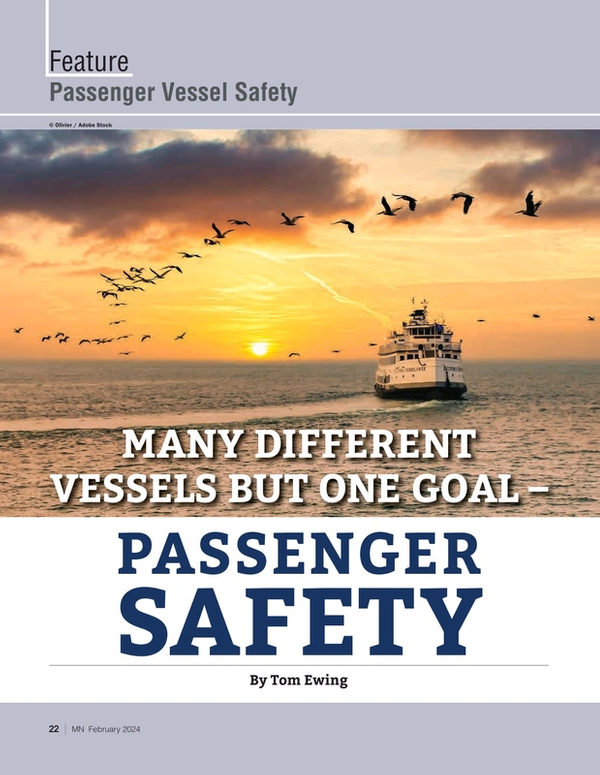
Many Different Vessels but One Goal – Passenger Safety
Because there are so many different kinds of passenger vessels, the critical topic of passenger safety can sometimes appear as a set of niche topics, each one just distantly connected to another. After all, passengers aboard a cruise ship in the Caribbean face safety issues that are much different than a commuter going from Jersey City to Manhattan or a tourist crossing from the Mukilteo, Wash. ferry terminal to Whidbey Island or a family on a fishing vessel in Miami.
Importantly, though, for passenger vessel operators, a commitment to safety is not siloed. Risks may vary but because even the slightest error or misjudgment can have tragic consequences, safety issues draw broad review: if new dangers arise for a ferry, is there even the slightest chance it could occur on a sightseeing vessel or an Ohio River dinner cruise?
This contrast between specific – sometimes very specific – and general comes to mind when considering the numerous safety advisories pertaining to recent amphibious DUKW boat tragedies or the 2019 Conception dive boat disaster off of Santa Cruz Island, Calif. It’s hard to imagine any captain or maritime operator not paying close attention to all of the issues raised by the U.S. Coast Guard (USCG) or the National Transportation Safety Board (NTSB), even though most vessels may have little in common with a DUKW or dive boat.
This broader focus yields other information, beyond hardware and equipment: are regulatory agencies working together, particularly the USCG and the NTSB? Calls for heightened safety concerns in one vessel sector, can signal changes elsewhere, again, not necessarily with equipment but with new or revised industry-wide policies, e.g., inspections, permits, deadlines, safety reviews or new monitoring and reporting requirements (the NTSB is not a regulatory agency).
With passenger safety, the USCG-NTSB working partnership sometimes raises concerns. On August 31, 2023, for example, NTSB Chair Jennifer Homendy, sent a letter to USCG Commandant Admiral Linda Fagan, noting the fourth anniversary of the Conception tragedy. Homendy first cites numerous examples of the USCG and NTSB working cooperatively on critical issues. But her focus shifts to one outstanding issue: the NTSB recommended, after its Conception investigation, that the USCG require safety management systems (SMS) on all passenger vessels. Four years later, she notes with concern that the SMS proposal is in limbo.
“The time for action is now,” Homendy wrote to Fagan in August, “In honor of the 34 Conception victims and every other person who has lost their life on our nation’s waterways, I strongly encourage you to issue SMS regulations within the next 30 days.” A copy of the letter was sent to 10 members of Congress.
Homendy notes that, in fact, the USCG did issue an SMS Advance Notice of Proposed Rulemaking for passenger vessels in January 2021. But “progress has been stalled,” she wrote, and that Advance Notice hasn’t advanced.
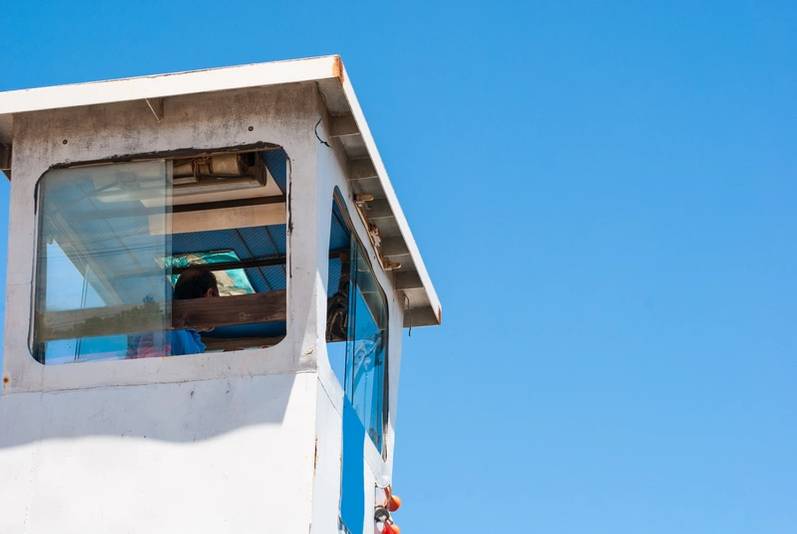 Workforce issues remain a top concern for passenger vessel operators. (© Hesitantpatcha / Adobe Stock)
Workforce issues remain a top concern for passenger vessel operators. (© Hesitantpatcha / Adobe Stock)
Regulatory impacts vary
In its 2021 notice the USCG includes some important, related statistics:
- There are approximately 6,500 active and inspected passenger vessels in the U.S-flag fleet.
- Of these, 530 are already required by domestic law to have SMSs, in accordance with International Maritime Organization (IMO) treaty obligations, because they transport more than 12 passengers on foreign voyages.
- From 2017 to 2019, there were a total of six vessel-related fatal accidents on passenger vessels, resulting in 55 deaths, 34 from the Conception.
- Five of the six fatal incidents, and 54 of the 55 deaths, involved vessels without an SMS in place.
Hence the USCG’s core question: how many and what kind of accidents and fatalities might be prevented by requiring SMSs on some subset of passenger vessels? An SMS is not a casual check-the-box safety review. An SMS program presents significant costs for small business vessel operators. A New York ferry operator, for example, wrote in response to the USCG’s 2021 SMS Notice, that he did not want to be dismissive of safety and documenting safe operations, but “a full blown SMS can be very costly to many small passenger vessel operations while inheriting (sic) a blow to their bottom line income.” He commented further: “Don’t drag this fleet into the same discussion of the deep draft fleet.”
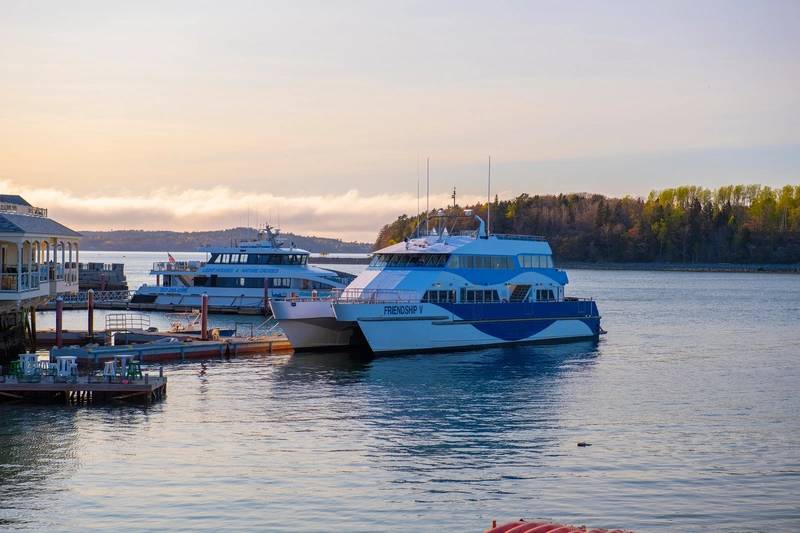 © Wangkun Jia / Adobe Stock
© Wangkun Jia / Adobe Stock
Any upcoming meetings?
In early January, NTSB was asked about its working relationship with the USCG.
Jennifer Gabris is on NTSB’s media relations team. In an email she said NTSB and USCG staff work on nearly 50 cases each year. Agency personnel are in daily contact, she said, with formal meetings twice a year. “The level of cooperation is the best it has ever been,” she commented.
Gabris said SMS for passenger vessels remains a top NTSB issue. “We look forward to a USCG rulemaking on this as soon as possible,” she said.
Other top NTSB issues include a recommendation for voyage data recorders (VDR), or similar devices, on board passenger vessels. It’s NTSB’s position that recordings of conversations and parametric data are preferable to interviewing participants whose memories can be incorrect; better, objective data will produce better reports and safety recommendations. Another recommendation: provide shipboard employees with personal locator beacons (PLB) to aid in the location of persons in the water.
One idea suggested after the USCG’s 2021 SMS notice was that smaller passenger vessel operators could adopt a program similar to the Flagship SMS established in 2017 for members of the Passenger Vessel Association (PVA). Interestingly, in the Flagship document, PVA acknowledges and thanks the USCG for its help in developing a “voluntary alternative safety management system for the domestic passenger vessel industry.”
One recent legislative change forcing the USCG to be more responsive to NTSB recommendations is a requirement within the “James M. Inhofe National Defense Authorization Act for Fiscal Year 2023,” signed by President Biden in December 2022. That requirement directs the USCG to submit to the NTSB a report, within 90 days, whether the USCG agrees with the NTSB’s recommendations, partially agrees or does not agree. If the USCG agrees it has to outline the actions it will take to implement NTSB’s recommendations.
NTSB was asked about that directive and new USCG reports. Gabris said, “The Coast Guard now has staff dedicated to handling internal and external safety recommendations like ours.” The NTSB transmitted Safety Recommendations M-23 (3,4 and 5) to the USCG on October 24, 2023, files pertaining to the fire aboard the Spirit of Norfolk. The NTSB received the USCG’s initial response in mid-January 2024.
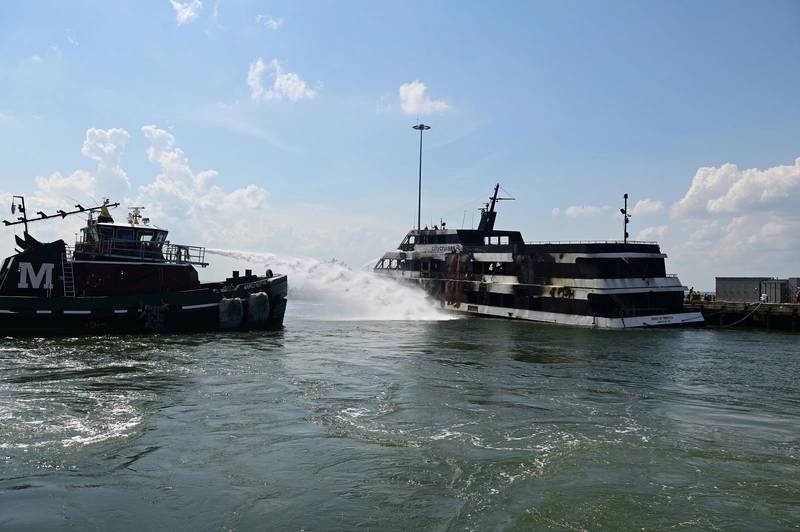 Responders battle a fire that broke out aboard the passenger vessel Spirit of Norfolk in Norfolk, Va., in June 2022. More than 100 passengers, the vast majority of them school children, were rescued. (Photo: Edward Wargo / U.S. Coast Guard)
Responders battle a fire that broke out aboard the passenger vessel Spirit of Norfolk in Norfolk, Va., in June 2022. More than 100 passengers, the vast majority of them school children, were rescued. (Photo: Edward Wargo / U.S. Coast Guard)
Bigger vessels
The Passenger Vessel Association is a national trade and advocacy association that works on behalf of its membership. John Groundwater is Executive Director. He was asked about PVA’s top passenger safety issues. He mentioned two:
- PVA expects the USCG to issue SMS regulations soon for certain passenger vessels.
- Crew shortages have caused operators to change schedules. Obviously, there’s no passenger safety without required staffing. PVA is working with many of the maritime academies to promote careers in the passenger vessel industry.
Groundwater said these challenges exist within generally positive business conditions. In an email he wrote that the U.S. passenger vessel industry has largely recovered from the COVID-19 pandemic, and some operations report revenue at or exceeding 2019 levels. He said that dinner boat and charter operators report increasing corporate and group bookings, and the ferry industry has pointed to growing commuter traffic. “In addition,” he added, “several small U.S. overnight cruise and ferry operators are building new vessels, which is a sign of industry health.”
 © Jill Clardy / Adobe Stock
© Jill Clardy / Adobe Stock
Ferries: Heavy traffic
According to U.S. Bureau of Transportation Statistics (BTS), ferries in the U.S. carried 132 million passengers in 2019, provided through 760 terminals on 1,106 unique route segments in 40 states, three U.S. territories, and two Canadian Provinces, using a fleet of 839 active vessels. Sixty-seven percent of operators reported that ferry transit was for work trips; 59% for recreational destinations.
Internationally, that passenger volume is even more eye-opening. The trade association Interferry, which represents ferry operators and businesses worldwide, calculates that ferries in 2019 globally carried 4.27 billion passengers and 373 million vehicles (cars, buses and trailers) on 15,400 ferry vessels.
Mike Corrigan is Interferry’s CEO, based in Canada. Corrigan was asked about passenger vessel safety issues that are top concerns for ferry operators at the start of 2024. On an international level he noted work to increase operational safety in developing countries, to make it as safe as ferry service in developed nations. Interferry has a “FerrySafe initiative” that helps operators in various countries. He cited recent program successes in the Philippines. Projects will start soon in Africa.
Regarding fire safety, Interferry has worked closely with the European LASH Fire project which got underway in 2019 and wrapped up its work at the end of August this year.
LASH stands for “Legislative Assessment for Safety Hazards of Fire.” LASH Fire was an international research project seeking to significantly reduce the risk of fires on board ro-ro (roll on–roll off) ships. Corrigan said that Interferry’s Fire Protection Working Group was a primary source for interaction with the ro-ro industry. He said LASH has published numerous reports and advisories about ways to improve vessel safety.
Corrigan said that one key highlight was evaluating the efficacy of conventional seawater drencher systems in relation to battery electric vehicle (BEV) fires. LASH Fire researchers tested a fixed water-based extinguishing system on a simulated ro-ro deck with a thermal runaway fire in a BEV. This work showed that the drencher system was capable of containing the fire and the conclusion that the overall risk of carrying BEVs should be considered equivalent or lower than that of internal combustion engine vehicles (ICEV), providing the drencher system is correctly operated and designed in accordance with SOLAS (Safety of Life at Sea) demands. Another work product is a 39-page set of recommendations for decision-making about fire risk and related technical issues.
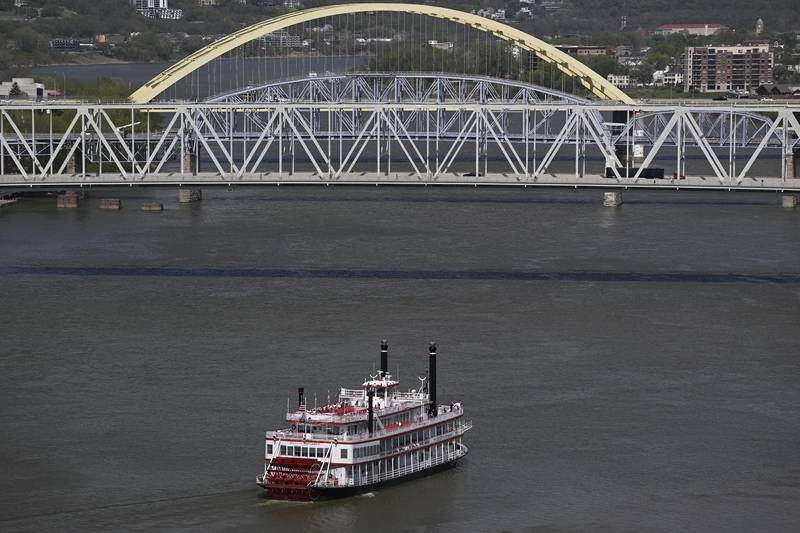 © Eyes2Soul / Adobe Stock
© Eyes2Soul / Adobe Stock
In the U.S., last February, the Coast Guard issued a Marine Safety Alert: “Saltwater intrusion causes damage to electric vehicle batteries.” This Alert followed flooding after Hurricane Ian hit Florida and southeast states. The alert was not specifically directed at passenger vessels but more broadly at vessels, ports and shippers who, the USCG wrote, “should be aware of this extreme risk and avoid loading EVs with damaged lithium-ion onto commercial vessels.”
NTSB follows the use and transportation of lithium batteries in all modes, including maritime. Their staff includes fire and hazardous materials investigators that specialize in this Li-battery transportation risks. Gabris said, “The NTSB routinely works with international investigative partners and attends meetings at the IMO to track Li-battery and other safety issues, particularly in the area of marine fire detection and extinguishment.”
In San Franciso, Patrick Murphy is president of the Blue & Gold Fleet, which provides ferry and water excursion services on San Francisco Bay and regular ferry service to Sausalito.
Murphy said B&G does not operate car ferries, so LI-battery safety is not an issue. However, he expects the USCG to issue LI-battery and fire safety guidelines soon. Workforce recruitment, though, “is top of mind for us,” Murphy commented. He said B&G is working with union halls and workforce development programs in the City of Richmond and in Oakland. “We have put together a group,” Murphy explained, “that has called itself the Working Waterfront Coalition to help recruit and train future mariners and shipyard workers.”
 © sheilaf2002 / Adobe Stock
© sheilaf2002 / Adobe Stock
In Canada
In Ottawa, the Canadian Ferry Association (CFA) serves as the national voice of the ferry industry. Serge Buy is CFA’s chief executive officer. Buy was asked about CFA’s top passenger safety issues. He said there is no one, singular issue outstanding right now.
Buy was asked about concerns pertaining to EV batteries and, more generally, the transport of alternately fueled vehicles. In an email he wrote that “lithium batteries and ‘alt-fueled’ vehicles are a concern. We keep looking at evolving evidence on this issue and look forward to further guidance from the entity that regulates ferry operations in Canada: Transport Canada.”
Another top issue, just as in the U.S. – workforce recruitment, which he called a “key issue for ferry operators.” He said we either have the staff needed for safe transit – or crossings are cancelled. “I would say that this is the top issue throughout the ferry system in Canada today.” One positive step: Transport Canada has signed bilateral agreements to recognize the credentials of seafarers from certain other countries. That’s a slow process, however, and Buy added that it isn’t fixing the workforce issue.
In 2024, passenger safety will undoubtedly progress along these many different fronts, advancing more quickly in some areas compared to others. The biggest goal: to make this progress deliberate, not something wrenched from the aftermath of an accident or tragedy.
Read Many Different Vessels but One Goal – Passenger Safety in Pdf, Flash or Html5 edition of February 2024 Marine News
Other stories from February 2024 issue
Content
- Insights: Catherine Gianelloni, MITAGS page: 10
- For Ferries to Go Green, Governments Will Need to Provide the Green page: 16
- Five Tips to Keep Workers Safe in 2024 page: 18
- Will 2024 Settle the Turbulence of US Offshore Wind? page: 20
- Many Different Vessels but One Goal – Passenger Safety page: 22
- US Offshore Wind: Down but Not Out page: 28
- MARAD’s Title XI Changes: Good News for Offshore Wind? page: 32
- Virtual Marine: Simulator Training is the Real Deal page: 34

